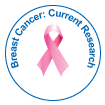Tislelizumab Plus Chemotherapy for Advanced Triple-Negative Breast Cancer: The Ideal Combination
Received: 01-Feb-2024 / Manuscript No. bccr-24-130285 / Editor assigned: 04-Feb-2024 / PreQC No. bccr-24-130285 (PQ) / Reviewed: 18-Feb-2024 / QC No. bccr-24-130285 / Revised: 20-Feb-2024 / Manuscript No. bccr-24-130285 (R) / Published Date: 27-Feb-2024 DOI: 10.4172/2592-4118.1000234
Abstract
Triple-negative breast cancer (TNBC) represents a particularly aggressive subtype of breast cancer, characterized by the absence of estrogen receptor (ER), progesterone receptor (PR), and human epidermal growth factor receptor 2 (HER2) expression. The lack of targeted therapies for TNBC underscores the urgent need for effective treatment strategies. Immunotherapy has emerged as a promising approach for TNBC, with the immune checkpoint inhibitor Tislelizumab showing encouraging results in combination with chemotherapy. This article reviews the rationale, clinical evidence, and future prospects of Tislelizumab plus chemotherapy for advanced TNBC.
Keywords
Tislelizumab; Chemotherapy; Triple-negative breast cancer (TNBC); Combination therapy
Introduction
Triple-negative breast cancer (TNBC) accounts for approximately 15-20% of all breast cancer cases and is associated with a poorer prognosis compared to other subtypes due to its aggressive nature and limited treatment options. The absence of ER, PR, and HER2 expression renders TNBC insensitive to hormonal therapies and HER2-targeted agents, necessitating the exploration of alternative treatment modalities. Immunotherapy has emerged as a promising strategy for TNBC, leveraging the host immune system to target cancer cells. Tislelizumab, a novel immune checkpoint inhibitor targeting programmed death receptor 1 (PD-1), has demonstrated efficacy and tolerability in various malignancies, including TNBC [1-3].
Methodology
Rationale for combination therapy: The tumor microenvironment of TNBC is characterized by immune evasion mechanisms, including upregulation of programmed death ligand 1 (PD-L1) expression, which facilitates immune escape. By targeting the PD-1/PD-L1 axis, tislelizumab reactivates T-cell-mediated antitumor immunity, thereby overcoming immune suppression and enhancing tumor cell killing. However, monotherapy with immune checkpoint inhibitors has shown limited efficacy in TNBC, necessitating combination approaches to enhance therapeutic outcomes [4,5]. Combining tislelizumab with chemotherapy offers a synergistic approach by promoting immunogenic cell death, enhancing antigen presentation, and modulating the tumor microenvironment to potentiate immune responses [6].
Clinical evidence: Clinical trials evaluating the combination of tislelizumab plus chemotherapy in advanced TNBC have shown promising results. The phase 3 trial, NCT03586661, investigated the efficacy and safety of tislelizumab in combination with nabpaclitaxel versus placebo plus nab-paclitaxel as first-line treatment for metastatic TNBC [7,8]. Preliminary results demonstrated a significant improvement in progression-free survival (PFS) and overall response rate (ORR) in the tislelizumab arm compared to the placebo arm, with manageable toxicity profiles. Subgroup analyses further highlighted the benefits of combination therapy across various patient populations, including those with PD-L1-positive and PD-L1-negative tumors [9,10].
Discussion
The promising efficacy and safety profile of tislelizumab plus chemotherapy in advanced TNBC warrant further investigation and validation in larger cohorts and real-world settings. Future research endeavors should focus on optimizing treatment regimens, exploring biomarkers predictive of response, and elucidating mechanisms of resistance to identify strategies to enhance treatment efficacy and durability. Additionally, the integration of tislelizumab-based combinations into the neoadjuvant and adjuvant settings holds potential for improving long-term outcomes and reducing the risk of disease recurrence in TNBC patients.
Conclusion
The combination of tislelizumab plus chemotherapy represents a promising therapeutic strategy for advanced TNBC, addressing the unmet need for effective treatment options in this aggressive subtype of breast cancer. By harnessing the synergistic effects of immunotherapy and chemotherapy, this approach offers the potential to improve clinical outcomes and redefine the treatment landscape for TNBC patients. Further research and clinical trials are warranted to validate these findings and establish the role of tislelizumab-based combinations as standard-of-care therapies for TNBC.
References
- Koulis TA, Phan T, Olivotto IA (2015) . Breast Cancer (Dove Med Press) 7: 363-370.
- Kim KS, Shin KH, Choi N, Lee SW (2016) . Radiat Oncol J 34: 81-87.
- Fernanda F Zimmermann, Beverley Burrell, Jennifer (2022) Jordan Patients’ experiences of a mindfulness intervention for adults with advanced cancer: a qualitative analysis 28: 4911-4921.
- Haviland JS, Owen JR, Dewar JA, Agrawal RK, Barrett J, et al. (2013) . Lancet Oncol 14: 1086-1094.
- Coles CE, Griffin CL, Kirby AM, Titley J, Agrawal RK, et al. (2017) . Lancet 390: 1048-1060.
- Giuliano AE, Ballman KV, McCall L, Beitsch PD, Brennan MB, et al. (2017) . JAMA 318: 918-926.
- McCart Reed AE, Kutasovic JR, Lakhani SR, Simpson PT (2015).Breast Cancer Res17: 12.
- Choi JS, Heang Oh S, Kim YM, Lim JY (2020) . Tissue Eng Regen Med 17: 651-658.
- William PS, Peter S, Theo P (2006) . Int J Cancer 118: 2048-2055.
- Sinn HP, Kreipe H (2013) . Breast Care (Basel) 8: 149-154.
, ,
, ,
, ,
, ,
, ,
, ,
, ,
, ,
, ,
, ,
Citation: Li X (2024) Tislelizumab Plus Chemotherapy for Advanced Triple-Negative Breast Cancer: The Ideal Combination. Breast Can Curr Res 9: 234. DOI: 10.4172/2592-4118.1000234
Copyright: © 2024 Li X. This is an open-access article distributed under theterms of the Creative Commons Attribution License, which permits unrestricteduse, distribution, and reproduction in any medium, provided the original author andsource are credited.
Select your language of interest to view the total content in your interested language
Share This Article
Recommended Journals
51ºÚÁϳԹÏÍø Journals
Article Tools
Article Usage
- Total views: 656
- [From(publication date): 0-2024 - Jun 24, 2025]
- Breakdown by view type
- HTML page views: 427
- PDF downloads: 229
